Combine tropical abundance with Chinese, Spanish and American influence, and you've got yourself a unique cuisine. Tangy meats, sweet breads and banana ketchup are just a few of the components of how people eat across the 7,600 or so islands. Despite the diversity of influence and the disperse geography, the national cuisine is surprisingly coherent, which made planning this meal pleasantly straightforward. Also a huge help was Andrew, our friend who's from outside of Manila.

Also joining us tonight were Laura, Melia, Mike, Kendra, Douglas, Joan, Hannah, Sam, Eric, Chelsea, and friends. Chelsea, by the way, is the one who redesigned this site and took our headshots — thanks so much!
Adobong manok | Chicken adobo | Recipe
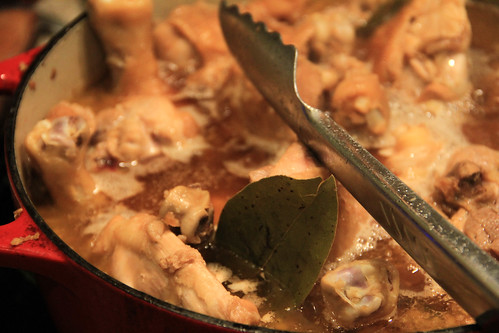
Despite the Spanish name, it’s believed that adobo’s been cooked in the Philippines since far before the conquistadores arrived. The acid from the vinegar and the salt from the soy sauce serve to preserve the meat for a while without refrigeration. The unsubtle delight of those bold flavors is what keeps people cooking it far after the arrival of the refrigerator.
It turns out this is a really easy dish to make, pretty much you just cook the meat in the sauce until it’s done to get a basic adobo. To make it even better, you cook remove the meat and cook down the sauce to concentrate it. And to really win, follow the variation in the recipe, and broil the chicken to crisp that skin up nice.
Lumpia | Spring rolls | Recipe
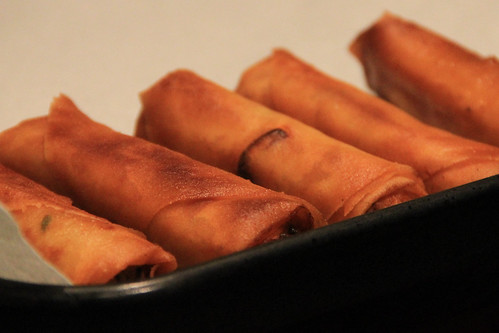
It’s no coincidence these look like spring rolls, as the Philippines’ favorite finger food was indeed introduced by Chinese immigrants. The only difference I can surmise is that this version is slimmer, so there’s a higher surface-to-filling ratio, and hence more crisp per bite. We served it with banana sauce, which for reasons I don’t understand is dyed bright red.
Lechon liempo | Barbecue pork belly | Recipe
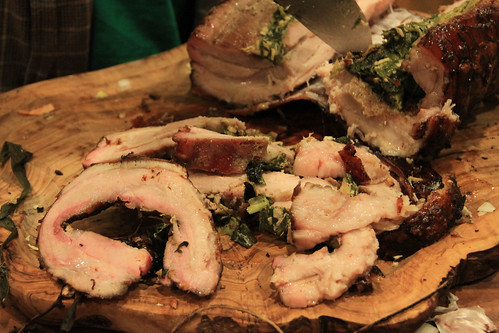
A roast suckling pig is a sign of a great Pinoy party, but we’d need a lot more than sixteen people to make it worthwhile. As crispy skin and unctuous fat are the most cherished qualities in lechon, a pork belly was the natural choice for a pig portion. This recipe, along with a few others, advises a roll-up like an Italian porchetta; I used some leeks from the yard as a substitute for the lemongrass because I’ve become allergic. (Here’s hoping that clears up before the Thailand meal!)
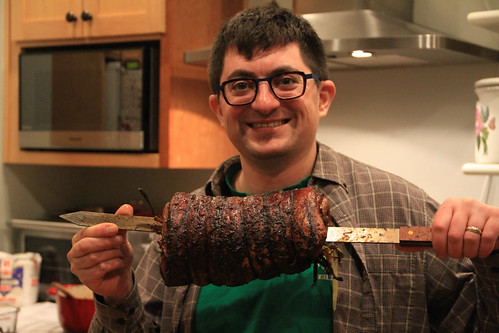
Even if we weren’t doing a whole animal, I wanted to get at least half of it right by cooking over coals. I don’t have a spit, but I came close by spearing the roll with two sword-like skewers and rotating it every 20 minutes or so, with a basting of soy sauce at every spin. I kept the coals low, slow, and indirect, so it took several hours to cook. It was so, so good, though it was really rich! I froze the leftovers; I’m thinking I’ll use it in a bean soup or simmered greens soon.
Sinigang na isda | Sour fish soup | Recipe
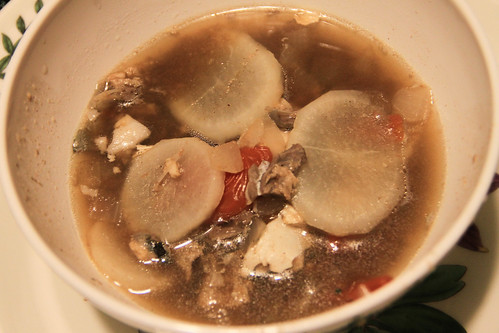
Some cuisines make a mockery of my inclination to cook a vegetable dish. Filipino recipe sites often have a “vegetables” section, but almost all the dishes in there have meat in one way or another! Sinigang is such an example: it has turnips and spinach and tomatoes so it’s definitely considered a vegetable dish, but it’s typically made with meat too
I was also fairly astonished by how, in a country of 7,107 islands, the standards of the cuisine seems so much heavier on meat than on fish and seafood even though the latter’s eaten plenty often. Sinigang is yet another dish that’s better known for being made with meat, but fortunately the seafood version is definitely a thing too.
In the end, the soup was okay but not great. Maybe I put in too little tamarind or fish sauce, or maybe my expectations were misaligned, but I found it to be pretty mild flavored.
Ube ice cream | Purple sweet potato ice cream
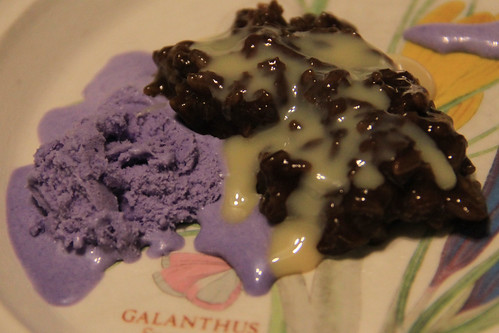
The Philippines has a very solid ice cream tradition. But many of the flavors are off the spectrum of what usually comes in the frozen tub. In addition to corn and coconut flakes, the element that most throws me for a loop is...cheese! Like, the same sort of yellow shredded cheese you’d put on your nachos.
But the most famous, and pretty, Filipino ice cream type is ube, the purple yam. In much the same way as a sweet potato pie, the tuber lends itself to sweet dishes both in terms of a nice flavor as well as adding just a bit of texture.
Champorado | Chocolate rice pudding | Recipe
Although there are plenty more famous desserts — there are multiple Filipino bakery chains in the US! — Andrew insisted not only that we make this chocolatey sweet rice pudding, but that he make it himself. He said the last time he ate it, at a restaurant in Brooklyn, he was immediately transported to memories of home -- and the other Pinoys at the table agreed. I can’t decide whether I liked this thick dessert better warm that night as dessert, or cold the next morning as breakfast, but in both instances a rich drizzle of condensed milk made it all the better.